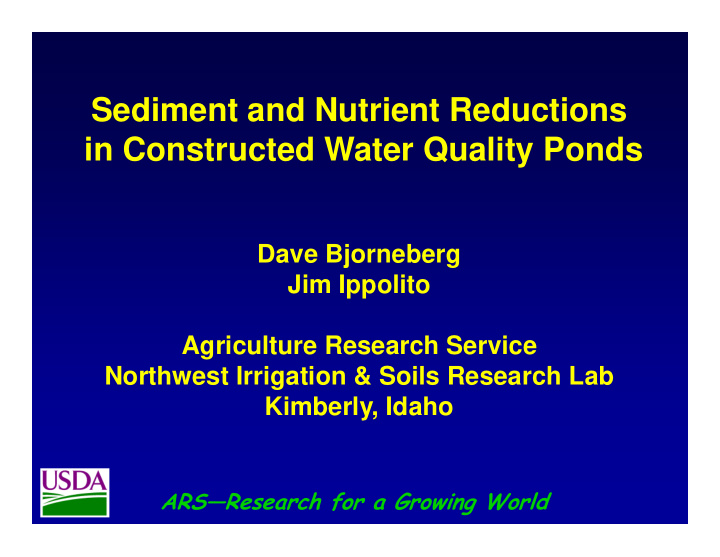



Sediment and Nutrient Reductions in Constructed Water Quality Ponds Dave Bjorneberg Jim Ippolito Agriculture Research Service Northwest Irrigation & Soils Research Lab Kimberly, Idaho ARS—Research for a Growing World
Northwest Irrigation & Soils Research Lab Kimberly, Idaho • 2 agricultural engineers • 6 soil scientists • 1 sugar beet geneticist • 1 sugar beet pathologist
Upper Snake Rock Conservation Effects Assessment Project Weekly samples from 26 sites from 2005-2008.
Irrigation Season Suspended Sediment Balance (May through September) 1000 Net Gain Suspended Sediment (kg/ha) 500 0 Inflow Outflow -500 Net Net Loss -1000 -1500 1971 2005 2006 2007 2008 Sediment loss has decreased since 1971 when watershed was 95% furrow irrigated.
Annual Dissolved Phosphorus Balance 1 Dissolve P (kg/ha) 0.75 0.5 Inflow 0.25 Outflow Net 0 -0.25 -0.5 1969 2005 2006 2007 2008
Annual Nitrate-N Balance 5 Nitrate-N (kg/ha) 0 -5 -10 Inflow -15 Outflow Net -20 -25 -30 -35 1969 2005 2006 2007 2008
No nitrate in irrigation water. Nitrate is from subsurface drain tunnels/tiles.
LS & LQ Drains (Pigeon Cove) Sediment Sediment Concentration Load Flow (mg/L) (tons) Year (acre-ft) 1971 880 1040 12400 2005 1430 400 7700 2006 1240 210 3500 2007 2220 70 2200
Sprinkler Irrigation: 5% in 1971, 35% in 2005
Pond Study Summary 1. Collected samples from five ponds for 2-3 days in May, July and September 2008. 2. Ponds were 2 to 10 years old and ¼ to 70 acres in size. 3. Retention time was 2 to 10 hours. 4. 20 to 80% reduction in sediment concentration. 5. Total phosphorus reductions were related to sediment reductions. 6. Dissolved phosphorus and nitrate concentrations were low with inconsistent reductions.
Britt Pond
Cedar Draw
Malone Pond
S Coulee
Lower Perrine Ponds
All significantly different
significantly different
significantly different
Questions?
Recommend
More recommend